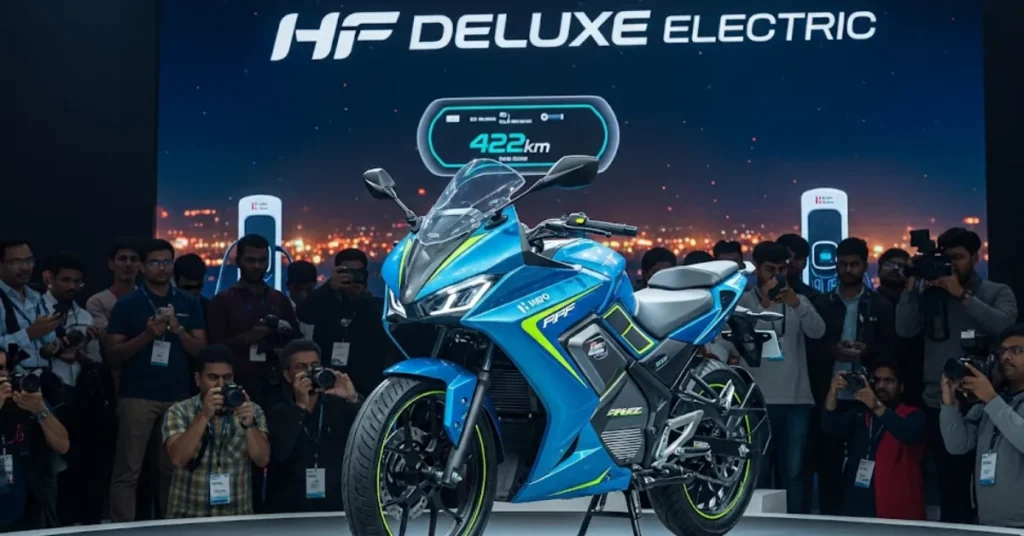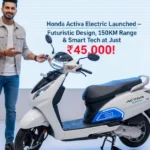The upcoming Hero HF Deluxe Electric 2025 is being imagined as the electric reincarnation of India’s most popular commuter motorcycle. Expected to make its way to the market by late 2025 or early 2026, this model would stand as Hero MotoCorp’s effort to offer budget-friendly and eco-conscious mobility. Designed for office-goers, students, and small-scale entrepreneurs, the EV version would carry forward the HF Deluxe’s reputation for dependability, now combined with modern electric performance. In India’s fast-changing EV landscape, this bike could prove to be a practical option for millions.

Simple Styling with Everyday Utility
The HF Deluxe Electric 2025 is likely to retain the no-nonsense commuter look of its petrol counterpart while adopting EV-friendly design cues. Built on a lightweight tubular steel frame, it would come in smart shades like Stealth Black, Eco Silver, and Bright Blue—perfect for riders seeking affordability without sacrificing appeal. The dimensions would hover around 1965mm in length, 720mm in width, and 1045mm in height, with a 1235mm wheelbase. Thanks to the compact electric setup, its kerb weight could stay between 95–105 kg, making it lighter than the fuel-powered model. An IP54 water- and dust-resistant certification would make it reliable under India’s unpredictable weather conditions.
Comfort and Digital Touches
A single-piece 805mm seat would deliver decent comfort for both the rider and pillion, with a functional grab rail at the back. On the tech front, a digital instrument console would pack in data such as battery health, estimated range, trip meter, and eco-driving indicators. Bluetooth pairing with the Hero mobile app might allow call alerts and simple navigation. Full LED illumination across the headlamp, tail section, and turn signals would keep visibility high while also keeping energy consumption low. Safety add-ons like a side-stand cut-off switch would maintain practicality without driving up the cost.
Electric Motor and Battery Setup
Powering the HF Deluxe Electric could be a BLDC hub motor rated at 2–3 kW (2.7–4 hp). Top speed would stay between 65–75 km/h, aligning with everyday city commutes and the occasional highway sprint. The motor would generate a lively 25–35 Nm of torque, giving it an edge over the petrol variant when it comes to initial pickup—0 to 40 km/h in just about 5.5 to 6 seconds. A 2.2–2.8 kWh lithium-ion pack (either fixed or removable) is expected to provide a reliable range of 90–110 km per charge. Multiple riding modes—Eco, City, and Power—under Hero’s EcoSmart management system could optimize output as needed.
Charging flexibility would be a major selling point. A 400W standard charger would top it up in 4–5 hours using a normal 5A socket, while a 1 kW fast charger (optional) could cut this down to around 2 hours. Regenerative braking would likely return an extra 5–10% of range, placing it head-to-head with scooters like the Bajaj Chetak Urbane and Ather 450S.
Handling and Suspension Setup
The motorcycle would sit on a double-cradle chassis for improved road manners. Suspension duties would be handled by front telescopic forks and adjustable twin rear shock absorbers, tuned to iron out potholes and bumps. A ground clearance of 170mm would give it a confident ride even on patchy village or semi-urban roads. Safety would be ensured with 130mm disc brakes up front and 130mm drum at the rear, assisted by a Combined Braking System (CBS). Rolling on 17-inch alloy wheels with tubeless tires (80/100 front and 100/80 rear), it would deliver fuss-free grip and low upkeep.
Everyday Features and Rider Safety
Practical features would be central to the HF Deluxe Electric’s design. Some likely inclusions are:
-
Digital console with real-time range and diagnostics
-
LED lighting package for efficiency
-
Smartphone charging port (USB-A)
-
Regenerative braking system with low-battery warning
-
Smart key with keyless start (on higher trims)
Safety protections such as CBS, overcharge prevention for the battery, and the side-stand engine cut-off would come as standard. Hero would probably skip advanced rider aids like ABS or traction control to keep costs down, positioning the model as a true value-for-money commuter.
Price Bracket and Rollout
The Hero HF Deluxe Electric 2025 is expected to debut at around ₹80,000–₹90,000 (ex-showroom). On-road costs would likely land close to ₹1 lakh, making it one of the cheapest electric motorcycles in the country. Availability could stretch across Hero dealerships and leading online partners like Flipkart, Amazon, JioMart, and Bajaj Finserv. Buyers might also see flexible EMI plans, exchange deals worth ₹5,000–₹8,000, and FAME-II subsidies (₹22,000, provided the scheme continues). Annual maintenance should remain low, estimated at ₹1,000–2,500 for basics like tire and battery checks, with Hero’s 6,000+ service points ensuring strong after-sales reach. Wait times could range from 10–25 days due to heavy demand.
Final Word
If introduced, the HF Deluxe Electric 2025 could become the most approachable EV motorcycle in India. With cheaper running costs (just ₹0.4–₹0.8 per km compared to ₹3–₹4 for petrol bikes), Hero’s dealership strength, and a lightweight build, it might strongly appeal to commuters, students, and delivery riders. Still, the relatively short range and bare-bones features may not win over long-distance or premium buyers. Competing with the TVS iQube S, Revolt RV1, and Ola S1 Air, Hero’s electric commuter would focus on delivering practical mobility with trusted reliability—making electric riding accessible for the masses.
Hi, my name is Hussain, the author behind Nirmalahss. I’ve always been passionate about exploring the latest in technology and automobiles, and this platform is my way of sharing that passion with others. Over the years, I’ve followed new gadgets, software trends, and the ever-changing auto industry closely, which has helped me develop a strong understanding of what truly matters to everyday users.
